The Soviet Austins
Russia was a customer and prolific user of the Austin series imported from Austin Motor Co. Ltd, Great Britain since 1914. Production was reserved entirely for Russia (and on Russian specs). The latest, the serie III was ordered on 25 August 1916 and integrated the sum of experience collected since the beginning of the war. These were delivered in early 1917, yet in the meantime another order came for an enhanced serie (which would have been the fourth) to be delivered in late 1917. The revolution erupted before and the vehicles were kept in British service.Still in 1916, the decision was taken to order but only chassis from Austin, to be completed locally by the Putilovski Works at Saint Petersburg. Therefore, 60 Serie III chassis were ordered and shipped. It was estimated their completion took place in july 1917. However the turmoil of the revolution brought all work to halt as stated by Staff-Captain Ivanov. It was eventually resumed by a few workers and the first two vehicles rolled out in march 1918 while Russia was no longer at war. Due to the lack of equipments, spare parts, even gasoline, all was tranferred by rail to the Izhorski Works. Production resumed there from the summer of 1919 to spring 1920, after 33 vehicles has been delivered in total. Interestingly enough, the designation "Austin-Putilov" (Остин-Путиловец - Ostin-Putilovets) is not attested in any document but was coined later by historians. Instead they were called Русский Остин - Russkij Ostin or "Russian Austins".
Design
The vehicles created by Putilovski Works and later Izhorski Works were virtually similar, integrating many ideas developed for the undelivered Austin serie IV. They were characterized by a bulky, heavier hull and thicker armour (7.5 mm instead of 6.5 mm) and by diagonally opposed turrets with Maxim liquid-cooled Machine guns for a better field of fire, but also a right side door. Overall weight was now Weight 5.2 tons and road speed fell to 55 km/h (? dubious), range to 200 km. These Austin-Putilov were indeed twice heavier than the 1914 serie I Austins (2.66 tons)!.They had a crew of five: The commander sat next to the driver in the front, while two machine-gunner and one loader/mechanic took place in the rear fighting compartment. In addition there was a duplicate steering for reverse driving, hence the protruding rear. Vision was provided by a large armoured folding windshield and side armoured hutters with four pistol ports. As customary the machine-guns were protected by blocking screens to avoid colliding themselves when traversing. They had revised mounts allowing full elevation and AA fire. The interior was layered with felt to protect the crew from metal splintering. The front road wheels were also protected by fenders.
At the same period, the Austin-Kégresse was developed, as the first military half-track. Both shared the same chassis and hull. Originally 39 Kégresse were planned, whereas ten Austins would have been delivered each month until 15 june 1917. The whole schedule was thrown away because of the late delivery of chassis: The first came in late january, and 20 total had been obtained by february 1917.
In action
These vehicles were pressed on service by the Red Army in the civil war, in motorized platoons called "armoured automobile units" (броневой автомоильный отряд or bronevoy avtomobilniy otryad), with three MG-armed cars, one gun/MG-armed, four staff cars, five trucks, plus a tanker, workshop trucks and four motorcycles. They saw action against the "white russians" but also independent groups or Ukrainian warbands and armies, and some were captured and reused by those. They also participated in the Polish-Russian war of 1920, and at least one was captured and stayed in service with the Polish Army until the 1930s.By 1921, the RKKA (future red army) registered only 78 vehicles of the serie III, Putilovs included. The last ones were retired from service in 1933. As of today the "Vrag Kapitala" (Enemy of the Capital) was displayed at the Artillery Museum, Saint Petersburg, falsely attributed to be the one on which Lening stood for his famous speech, which was impossible due to the timeframe, now at Kubinka. The other one is displayed as the Izhorski Works, in Kolpino, St. Petersburg.
Links & resources
The Austin on wikipedia (generic)The Austin Putilov on Landship II
On derela.republika.pl
| Austin-Putilov specifications | |
| Dimensions (L-W-H) | 4.9 x 2.03 x 2.84 m (16 x 6.8 x 9.4 ft) |
| Total weight, battle ready | 5.2 tons (10,400 lbs) |
| Crew | 5 (driver, commander, gunners, loader/mechanic) |
| Propulsion | Austin 4-cyl wc gas. 50 hp (37 kW) 9.5 hp/ton |
| Speed | 55 km/h? (34 mph) |
| Operational range (road) | 200 km (124 mi) |
| Armament | 2 x 7.62 mm (0.3 in) Maxim machine-guns, 5000 rounds |
| Suspension | 2x4 leaf springs. |
| Armor | 4 to 7.5 mm (0.25 in) |
| Total production | 33 in 1920 |
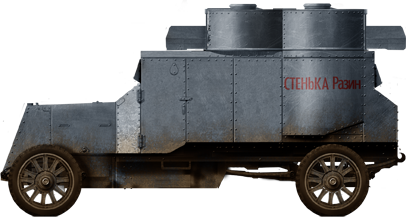
"Styenka Razin", 1920. It was captured by the 55th Infantry Regiment of the 14th Wielkopolska Infantry Division during the Soviet-Polish war and renamed "Poznańczyk". It was reused in the Wielkopolski Armoured Car Platoon.
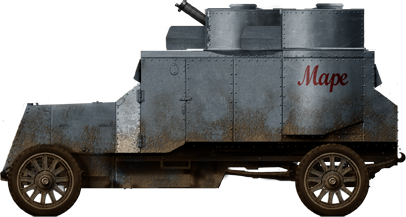
Another Austin-Putilov, 1920, Polish-Soviet war. As customary these vehicles were individually named by their crews. It seems nearly all hed been delivered with a neutral grey paint, or possibly pale olive, photos can't really tell, but it's unlikely as the paint would have been available from the Naval stocks.
Gallery
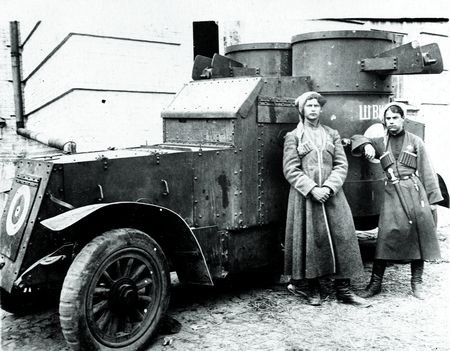
Austin Serie 3 with Cossacks, civil war era (notice the front hood cocard). The serie 3 was much lighter and had a two tandem turrets arrangement.
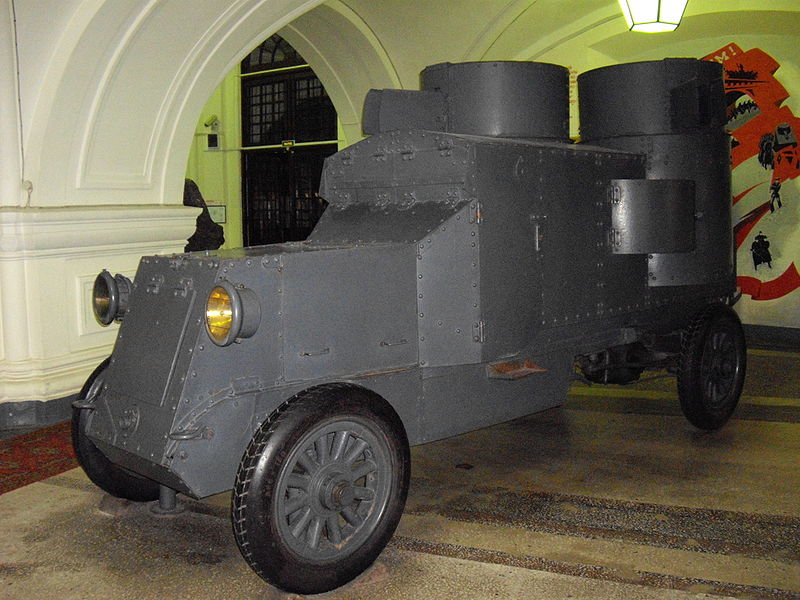
Austin-Putilovetz Vrag Kapital, photographed at the Artillery Museum (Saint-Petersburg).
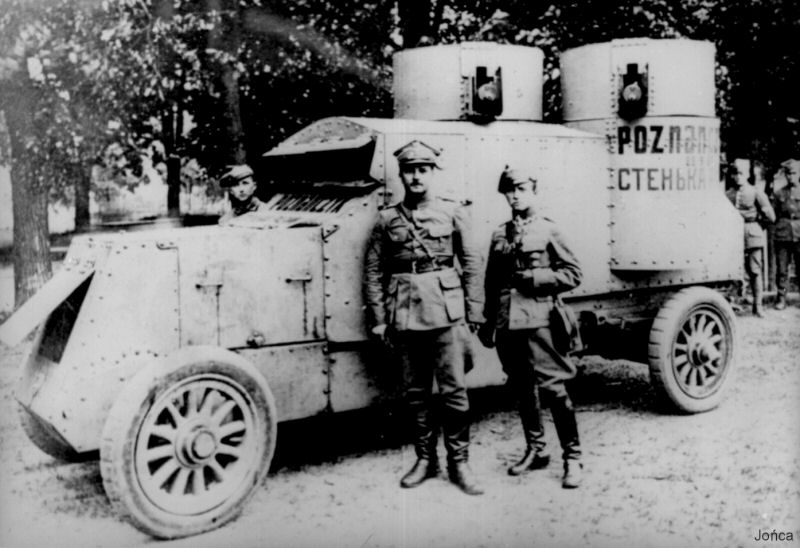
Catpured Austin-Putilovets «Poznańczyk» near Bobruysk, Poland, 1920.
 The Austin-Kégresse, developed over the standard Austin-Putilov. It was the world's first military half-track.
The Austin-Kégresse, developed over the standard Austin-Putilov. It was the world's first military half-track.
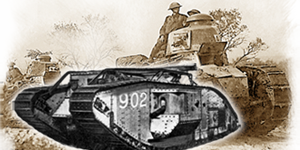
The Great War
 Austria-Hungary
Austria-Hungary Belgium
Belgium British Empire
British Empire France
France German Empire
German Empire Italy
Italy Russia
Russia USA
USAWW1 tanks posters

